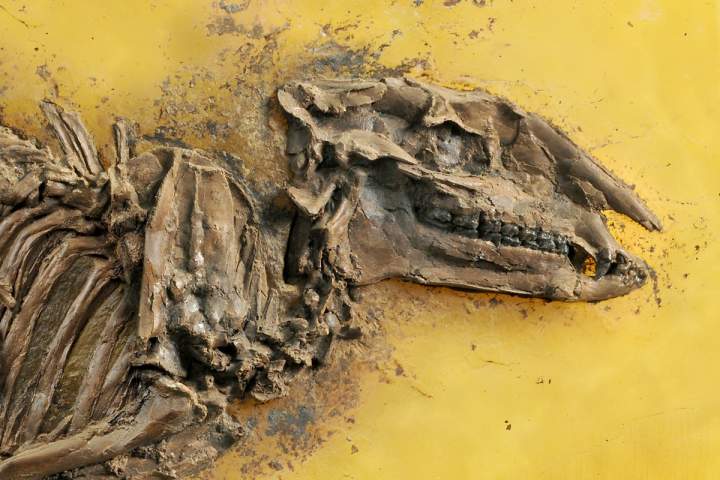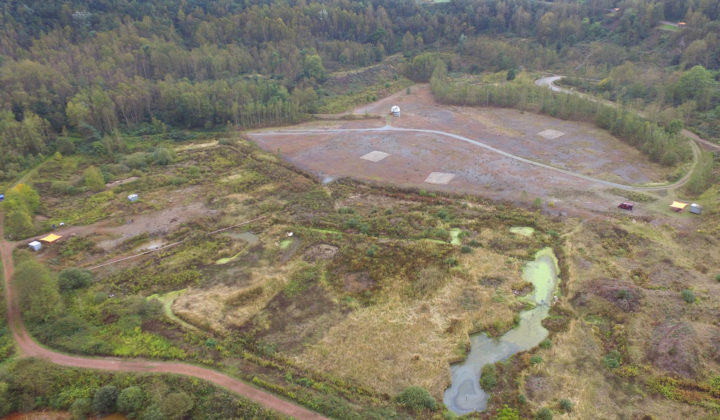
Current Positions
Head of Section in Messel Research, Senckenberg Research Institute and Natural History Museum, September 2023–present
Affiliate Faculty, Department of Atmospheric, Oceanic and Earth Sciences, George Mason University, Fairfax, VA, May 2021–present
Research Associate, Vertebrate Paleontology and The Dinosaur Institute, Natural History
Museum of Los Angeles County, Los Angeles, CA, July 2017–present
Research Associate, Vertebrate Zoology, Smithsonian National Museum of Natural History, Washington, DC, November 2018–present
Prior Positions
Research Assistant Professor, Vanderbilt University, August 2020–August 2023
Senior Lecturer, Vanderbilt University, August 2021–August 2023
Alexander von Humboldt Postdoctoral Research Fellow, October 2019–July 2021
Visiting Assistant Professor of Biology, W.M. Keck Science Department, Claremont McKenna, Pitzer, and Scripps Colleges, Claremont, CA, July 2018–July 2019
Postdoctoral Research Scholar, Department of Earth and Environmental Sciences, Vanderbilt University, Nashville, TN, July 2017–June 2018
Postdoctoral Research Scientist, The Dinosaur Institute, Natural History Museum of Los Angeles County, Los Angeles, CA, October 2015–July 2017
Postdoctoral Research Fellow, Howard University, Washington, DC, 2014–2015
Degrees Earned
PhD Vertebrate Paleontology, Yale University, 2008–2014 Dissertation title: “What goes on inside the heads of porpoises?: Internal anatomy in fossil and Recent porpoises based on CT scans” (PhD supervisor: Jacques Gauthier)
MPhil, Yale University, 2008–2011
MS Evolutionary Biology, San Diego State University, 2004–2007 (MS supervisor: Annalisa Berta)
BS Biology: Ecology, Evolution, and Conservation, The University of Texas at Austin, 1999–2002
Publications in Peer–Reviewed Journals And Volumes (*Student authors)
Vertebrates
Submitted/In review/In revision/In press
- Chochinov AV, Darroch SAF, Laflamme M, Racicot RA. (submitted) Phyllostomids (Chiroptera: Phyllostomidae) have a nose for good food: digital endocasts of New World leaf-nosed bats indicate dietary preference. Journal of Morphology
- Sanchez-Posada C, Racicot RA, Ruf I, Krings M, Rössner GE. (in revision) The oldest platanistoid dolphin from the Paratethys realm, Romaleodelphis pollerspoeckii, gen. et sp. nov. (Miocene, Austria). Journal of Vertebrate Paleontology.
2023
- Park T, Ekdale EG, Racicot RA, Marx FG (2023) Testing for convergent evolution in baleen whale cochleae. In Convergent Evolution. Animal Form and Function, V. Bels and A. Russell (eds). ISTE, London.
2022
- Racicot RA (2022) Evolution of whale sensory ecology: frontiers in nondestructive anatomical investigations. Anatomical Record. 305: 736–752.
- Racicot RA, Preucil VA* (2022) Bony labyrinths of the Blackfish (Delphinidae: Globicephalinae). Marine Mammal Science. 38: 29–41.
2021
- Kraatz B, Belabbas R, Fost L, Ge D, Lang M, Lopez-Torres S, Ravosa M, Racicot R, Sharp A, Sherratt E, Silcox M, Slowiak J, Winkler A, Zeinal M, Ruf I (2021) Lagomorphs as a model morphological system. Frontiers in Ecology & Evolution, Special issue “Recent Advances in the Evolution of Euarchontoglires” https://doi.org/10.3389/fevo.2021.636402
2020
- Galatius A, Racicot R, McGowen M, Olsen MT (2020) Evolution and diversification of delphinid skull shapes. iScience, 101543.
- Martins MCI*, Park T, Racicot RA, Cooper N. 2020. Intraspecific variation in the cochleae of harbour porpoises (Phocoena phocoena)and its implications for comparative studies across odontocetes. PeerJ 8:e8916.
2019
- Racicot RA, Darroch SAF, Boessenecker RW, Geisler J (2019) Evidence for convergent evolution of ultrasonic hearing in toothed whales (Cetacea: Odontoceti). Biology Letters 15: 20190083.
- Galatius A, Olsen MT, Steeman M, Racicot RA, Bradshaw CD, Miller LA (2019) Raising your voice: Evolution of narrow band high frequency signals in odontocetes. Biological Journal of the Linnean Society 126: 213–224.
2018
- Racicot RA, Darroch SAF, Kohno N. 2018. Neuroanatomy and inner ear labyrinths of the narwhal and beluga (Cetacea: Monodontidae). Journal of Anatomy 233: 421–439.
- Racicot RA (2018) Dolphins, porpoises, and monodontids, Evolution. In Encyclopedia of Marine Mammals (B. Würsig, J.G.M. Thewissen, and K.M. Kovacs, eds.), 3rd Ed, pp. 271–274, Academic Press/Elsevier, San Diego, CA, USA.
2017
- Racicot RA (2017) Fossil secrets revealed: X–ray CT scanning and applications in paleontology. In: L. Tapanila and I.A. Rahman (eds.), Virtual Paleontology. Paleontological Society Papers 22: 21–38.
- Field DJ, Boessenecker R, Racicot RA, Ásbjörnsdóttir L, Jónasson K, Hsiang A, Behlke A, Vinther J (2017) The oldest marine vertebrate fossil from the volcanic island of Iceland: A partial right whale skull from the high latitude Pliocene Tjörnes Formation. Palaeontology. 60: 141–148.
2016
- Racicot RA, Gearty W*, Flynn J, Kohno N (2016) Comparative anatomy of the bony labyrinth of extant and extinct porpoises (Cetacea: Phocoenidae). Biological Journal of the Linnean Society. 119: 831–846.
2015
- Hsiang AY, Field DJ, Webster TH, Behlke A, Davis MB, Racicot RA, Gauthier JA (2015) The origin of snakes: revealing the ecology, behavior, and evolutionary history of early snakes using genomics, phenomics, and the fossil record. BMC Evolutionary Biology 15:87.
- Ekdale EG, Racicot RA (2015) Anatomical evidence for low frequency sensitivity in the inner ear of Zygorhiza kochii (Cetacea, Basilosauridae). Journal of Anatomy 226: 22–39.
2014
- Racicot RA, Rowe T (2014) Endocranial anatomy of a new fossil porpoise (Odontoceti, Phocoenidae) from the Pliocene San Diego Formation of California. Journal of Paleontology 88: 652–663. (Cover Article)
- Racicot RA, Deméré T, Boessenecker R, Beatty B (2014) Unique feeding morphology in a new prognathous extinct porpoise from the Pliocene of California. Current Biology 24: 774 779. (Cover Article)
2013
- Racicot RA, Colbert MW (2013) Morphology and variation of porpoise (Cetacea: Phocoenidae) cranial endocasts. Anatomical Record 296: 979–992.
- Racicot RA, Berta A (2013) Comparative morphology of True Porpoise (Cetacea: Phocoenidae) pterygoid sinuses: Phylogenetic and Functional Implications. Journal of Morphology 274: 49–62. (Cover Article)
2009
- Burns KJ, Racicot RA (2009) Molecular phylogenetics of a clade of lowland tanagers: Implications for avian participation in the Great American Interchange. The Auk 126: 635–648.
2005
- Colbert MW, Racicot RA, Rowe T (2005) Anatomy of the cranial endocast of the bottlenose dolphin, Tursiops truncatus, based on HRXCT. Journal of Mammalian Evolution 12:195–207.
Invertebrates
2022
- Darroch SAF, Gibson BM, Syversen M*, Rahman IA, Racicot RA, Dunn FS, Gutarra-Diaz S, Schindler E, Wehrmann A, Laflamme M. (2022) The life and times of Pteridinium simplex. Paleobiology. DOI: 10.1017/pab.2022.2.
2021
- Darroch SAF, Cribb AT*, Buatois LA, Germs GJB, Kenchington CG, Smith EF, Mocke H, O’Neil GR, Schiffbauer JD, Maloney KM, Racicot RA, Turk KA*, Gibson BM*, Almond J, Koester B*, Boag TM, Tweedt SM, Laflamme M (2020) The trace fossil record of the Nama Group, Namibia: exploring the terminal Ediacaran roots of the Cambrian explosion. Earth Science Reviews, 212, 103435.
2020
- Maloney KM, Boag TH, Facciol AJ, Gibson BG, Cribb A, Koester BE, Kenchington CG, Racicot RA, Darroch SAF, Laflamme M (2020) Palaeoenvironmental analysis of Ernietta-bearing Ediacaran deposits in southern Namibia. Palaeogeography, Palaeoclimatology, Palaeoecology 556, 109884.
2019
- Cribb AT, Kenchington CG, Koester B, Gibson BM, Boag TH, Racicot RA, Mocke H, Laflamme M, Darroch SAF (2019) Increase in metazoan ecosystem engineering prior to the Ediacaran–Cambrian boundary in the Nama Group, Namibia. Royal Society Open Science 6: https://doi.org/10.1098/rsos.190548.
- Gibson BM, Rahman I, Maloney K, Racicot RA, Mocke H, Laflamme M, Darroch SAF (2019) Gregarious suspension feeding in a modular Ediacaran organism. Science Advances 5:eaaw0260.
- Clark EG, Fezzaa K, Burke JE, Racicot RA, Shaw JO, Westacott S, Briggs DEG (2019) A farewell to arms: using X-ray synchrotron imaging to investigate autotomy in brittle stars. Zoomorphology https://doi.org/10.1007/s00435-019-00451-7.
2017
- Darroch SAF, Rahman IA, Gibson B, Racicot RA, Laflamme M (2017) Inference of facultative mobility in the enigmatic Ediacaran organism Parvancorina. Biology Letters 13: 20170033.
2016
- Darroch SAF, Boag T, Racicot RA, Tweedt S, Mason S, Erwin DH, Laflamme M (2016) A mixed Ediacaran–metazoan assemblage from the Zaris Sub–basin, Namibia. Palaeogeography, Palaeoclimatology, Palaeoecology. 459: 198–208.
2015
- Rahman I, Darroch SAF, Racicot RA, Laflamme M (2015) Suspension feeding in the enigmatic Ediacaran organism Tribrachidium demonstrates complexity of Neoproterozoic ecosystems. Science Advances 1:10, e1500800.
- Darroch SAF, Sperling EA, Boag T, Racicot RA, Mason SJ, Morgan AS, Tweedt S, Myrow P, Johnston DT, Erwin DH, Laflamme M (2015) Biotic replacement and mass extinction of the Ediacara biota. Proceedings of the Royal Society B. 282: 20151003.
2012
- Vinther J, Jell P, Kampouris G, Carney R, Racicot RA, Briggs DEG (2012) The origin of multiplacophorans – convergent evolution of Aculiferan molluscs. Palaeontology 55:1007–1019.
Publications in Preparation (draft stage with figures)
Racicot RA, Budd AF, Huang D, Smith ND. Morphological data partitions possess different levels of phylogenetic signal for the evolutionary relationships of the reef coral families Merulinidae, Montastraeidae, and Diploastraeidae (Cnidaria: Anthozoa: Scleractinia).
Kofranek A-K M, Boessenecker RW, Darroch SAF, Ruf R, Racicot RA. First porpoise fossils (Artiodactyla: Phocoenidae) from the Pliocene of South Carolina Goose Creek Formation shed light on their sensory performance and biogeography.
Racicot RA, Ruf R. Development of the brain of the Pantropical spotted dolphin (Stenella attenuata).
Other Publications
Racicot RA, Ruf I (2020) MicroCT scans of an iodine stained prenatal rabbit. https://www.morphosource.org/projects/0000C1184
Palaeontology [online] editorial board (2018) Perspectives – Palaeontology in 2017. Palaeontology [online], Volume 7, Article 12, 1–14.
Palaeontology [online] team (2016) Perspectives: 2015 in Palaeontology. Palaeontology[online], Volume 6, Article 1, 1–6.
Racicot RA (2014) Fossil Focus: Porpoises. Palaeontology [online], Volume 4, Article 10, 1–8.
Racicot RA and Colbert MA (2002) “Tursiops truncatus” (online), Digital Morphology. http://digimorph.org/specimens/Tursiops_truncatus/.

RESEARCH INTERESTS
Paleobiology; evolution; phylogeny; geometric morphometrics; µCT scan investigation; adaptation to aquatic life; emergence of echolocation; origin of cetaceans;
Mammalogy; Artiodactyla; endemic European Paleogene artiodactyls; Cetancodonta; “archaeocetes”; Protocetidae; Raoellidae; Xenorophidae; Simocetidae;
Anatomy; tympanic bulla; ear ossicles; petrosal; bony labyrinth.
ACADEMIC POSITION
Since 2024 Postdoctoral researcher, Division Messel Research & Mammalogy, Senckenberg Research Institute and Natural History Museum, Frankfurt am Main
EDUCATION
2019 PhD in Palaeobiology
“The auditory region of Artiodactyla: phylogenetical and ecological signals”
CNRS – Institut des Sciences de l’Évolution de Montpellier (ISEM)
2015 Master’s degree in Palaeontology
Université Montpellier 2 – Institut des Sciences de l’Évolution de Montpellier (ISEM)
Université de Poitiers – Institute of Paleoprimatology, Human Paleontology: Evolution and Paleoenvironments (iPHEP)
2012 Bachelor’s degree in Science of Earth, Universe and Environment Université de Strasbourg – Université Montpellier 2
Orliac, M. J., Mourlam, M. J., Boisserie, J. R., Costeur, L. and Lihoreau, F. 2023. Evolution of semiaquatic habits in hippos and their extinct relatives: insights from the ear region. Zoological Journal of the Linnean Society, 198(4): 1092-1105. doi: 10.1093/zoolinnean/zlac112
Hautier, L., Tabuce, R., Mourlam, M. J., Kassegne, K. E., Amoudji, Y. Z., Orliac, M.J., Quillévéré, F., Charruault, A.-L., Johnson, A. K. and Guinot, G. 2021. New middle Eocene proboscidean from Togo illuminates the early evolution of the elephantiform-like dental pattern. Proceedings of the Royal Society B, Biological Sciences, 288(1960): 20211439. doi: 10.1098/rspb.2021.1439
Kassegne, K. E., Mourlam, M. J., Guinot, G., Amoudji, Y. Z., Martin, J. E., Togbe, K. A., Johnson, A. K. and Hautier, L. 2021. First partial cranium of Togocetus from Kpogamé (Togo) and the protocetid diversity in the Togolese phosphate basin. Annales de Paléontologie, 107(2): 102488. doi: 10.1016/j.annpal.2021.102488
Assemat, A., Mourlam, M. J., Weppe, R., Maugoust, J., Antoine, P.-A. and Orliac, M. J. 2020. The ossicular chain of Cainotheriidae (Artiodactyla, Mammalia). Journal of Anatomy, 237(2): 250-262. doi: 10.1111/joa.13190
Mourlam, M. J. and Orliac, M. J. 2019. Early Evolution of the Ossicular Chain in Cetacea: Into the Middle Ear Gears of a Semi-Aquatic Protocetid Whale. Proceedings of the Royal Society B, Biological Sciences, 286(1912): 20191417. doi: 10.1098/rspb.2019.1417
Mourlam, M. J. and Orliac, M. J. 2017. Infrasonic and ultrasonic hearing evolved after the emergence of modern whales. Current Biology, 27(12): 1776-1781. doi: 10.1016/j.cub.2017.04.061
Mourlam, M. J. and Orliac, M. J. 2017. Protocetid (Cetacea, Artiodactyla) bullae and petrosals from the middle Eocene locality of Kpogamé, Togo: new insights into the early history of cetacean hearing. Journal of Systematic Palaeontology, 16(8): 621-644. doi: 10.1080/14772019.2017.1328378
Data Paper
Hautier, L., Tabuce, R., Kassegne, K. E., Amoudji, Y. Z., Mourlam, M. J., Orliac, M.J., Quillévéré, F., Charruault, A.-L., Johnson, A. K. and Guinot, G. 2021. 3D models related to the publication: New middle Eocene proboscidean from Togo illuminates the early evolution of the elephantiform-like dental pattern. MorphoMuseuM, doi: 10.18563/journal.m3.145
Kassegne, K. E., Mourlam, M. J., Guinot, G., Amoudji, Y. Z., Martin, J. E., Togbe, K. A., Johnson, A. K. and Hautier, L. 2021. 3D models related to the publication: First partial cranium of Togocetus from Kpogamé (Togo) and the protocetid diversity in the Togolese phosphate basin. MorphoMuseuM, doi: 10.18563/journal.m3.143
Assemat, A., Mourlam, M. J. and Orliac, M. J. 2020. 3D models related to the publication: The ossicular chain of Cainotheriidae (Artiodactyla, Mammalia). MorphoMuseuM, doi: 10.18563/journal.m3.110
Mourlam, M. J. and Orliac, M. J. 2019. 3D models related to the publication: Early Evolution of the Ossicular Chain in Cetacea: Into the Middle Ear Gears of a Semi-Aquatic Protocetid Whale. MorphoMuseuM, doi: 10.18563/journal.m3.94
Orliac, M. J. and Mourlam, M. J. 2017. 3D models related to the publication: Infrasonic and ultrasonic hearing evolved after the emergence of modern whales. MorphoMuseuM, doi: 10.18563/m3.3.2.e4
Mourlam, M. J. and Orliac, M. J. 2017. 3D models related to the publication: Protocetid (Cetacea, Artiodactyla) bullae and petrosals from the middle Eocene locality of Kpogamé, Togo: new insights into the early history of cetacean hearing. MorphoMuseuM, doi: 10.18563/m3.3.1.e2


